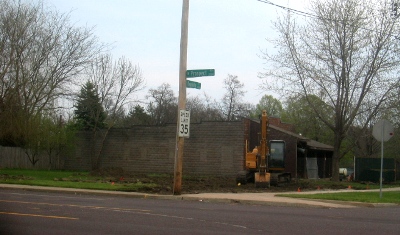I attended a Park Board meeting for the first time tonight. Can I just say their meeting room is tiny! They need a bigger place to meet.
While they handled all the normal business of a Park Board meeting, the big issue on the agenda was their plan to establish an historic preservation policy. President Tim Cassidy suggested that the board appoint an ad hoc committee to develop and propose the policy on historic preservation. He would like to see them complete their work within six to eight weeks. The ad hoc committee would consist of two trustees, two park district staff members, and a citizen, plus Cassidy and Bonnie Noble who attend all subcommittee meetings. The policy will cover all park district properties, not just Glen Oak Park. While Cassidy made the suggestion, Trustee Cummings made the motion; it was seconded and passed unanimously.
During discussion, Cassidy said he was not suggesting this simply because of the flap with the city, but because he thought it would be a good idea. Also, Trustees Allen and Petty both said they believed the Park Board had been doing a good job of preserving the parks’ historic treasures already. Cassidy agreed, but added that board members and staff members come and go and that a policy would ensure consistency in protecting historic assets.
On that last point, I can’t help but wonder if, on their way home tonight, those trustees happened to drive by the foot bridge that has been cordoned off and deteriorating for years, or if they perhaps remembered their votes from February 2006 when they decided to dismantle the parapet and relocate the Spanish cannon. I could go on. The point is that I found these statements to be the height of irony.
Later, during the time they allow citizens to address the board, Jane Leathers made mention of the oft-cited “27 acres” that the Park District is supposedly razing for the Africa zoo exhibit. Bonnie Noble countered that the whole project encompasses only six acres, so she’s at a loss to know from where the 27-acre claim is coming. After the meeting, Sara Partridge mentioned that it was in the documents the Park Board filed with the City. I don’t have time to check into it now — can anyone provide some insight on this? In any case, Noble said that they are only clearing six acres, not 27.
Also during the citizens-to-address portion, I made the following statement:
In 1997, the board considered the question of whether or not to televise Park Board meetings on the public access channel of our local cable provider. The proposal was defeated. I request that the board reconsider that decision and approve televising the Park Board meetings.
A functioning democracy requires an informed citizenry. Citizens oversee governmental bodies to, among other things, guard against abuse and ensure decisions are being made using accurate and timely information. Franklin Delano Roosevelt said, “The only sure bulwark of continuing liberty is a government strong enough to protect the interests of the people, and a people strong enough and well enough informed to maintain its sovereign control over the government.”
It is incumbent upon governmental bodies to conduct the public’s business in public and to provide information in a way that is easily accessible to the public. By televising your board meetings, you will greatly enhance accessibility and transparency in the execution of the Park Board’s business. Taxpayers can watch from home or tape the meeting to watch at a later time if they are unable to attend in person due to scheduling conflicts or work situations. Citizens would be allowed to oversee government on their schedule instead of the Park Board’s.
Some have countered that televising meetings could lead to board members preening for the cameras or making long-winded speeches. While these possibilities exist, they are not an excuse for limiting the public’s access to the affairs of this body. If the fear of long speeches is really the issue, the Park Board can easily overcome that obstacle by instituting a self-imposed time limit on debate.
I’ve talked to Insight Communications, and they have indicated they are willing to work with the Park District to televise board meetings either live or on a tape-delayed basis. While there is cost associated with doing a live feed to Insight, tape-delaying the meeting is a viable alternative. Further, having park staff do the taping would also lower costs.
Since accessibility can be provided at very low cost, the benefits are great, and the risks are low, I would implore the Board of Trustees to approve and implement televising of the Park Board meetings.
After reading this statement, Trustee Cummings made a motion to direct park district staff to research the costs of televising the meetings and report back to the park board so the board can consider it. The motion was seconded and passed unanimously. This was surprising to me, since I’m used to the Peoria City Council’s citizens-to-address policy where they don’t engage in dialog or take any immediate action, but merely listen to your statement.
I was pleased to hear the favorable discussion and hope that it results in the meetings being televised soon. I really do think it would be a valuable service to the community. Trustee Cummings made a good point that televising the meetings would also be good publicity for park board events and services, such as the ones they discussed tonight.


 The
The 
 Two citizens petitioned the City’s Historic Preservation Commission to designate all of Glen Oak Park an historic landmark. The commission wasn’t ready to take on the whole park, but they did recommend landmarking several specific structures within the park. The City Council has the final decision on whether to landmark the nine items, so it was on the agenda Tuesday.
Two citizens petitioned the City’s Historic Preservation Commission to designate all of Glen Oak Park an historic landmark. The commission wasn’t ready to take on the whole park, but they did recommend landmarking several specific structures within the park. The City Council has the final decision on whether to landmark the nine items, so it was on the agenda Tuesday.